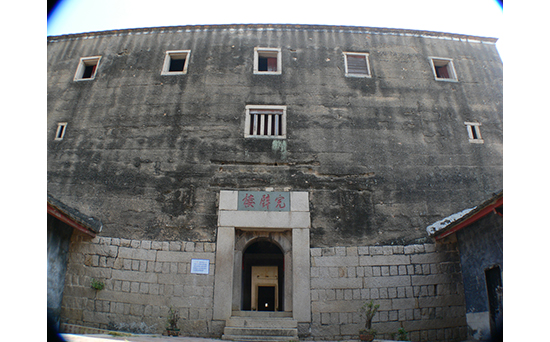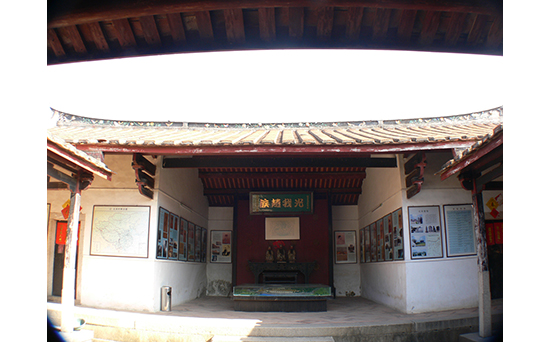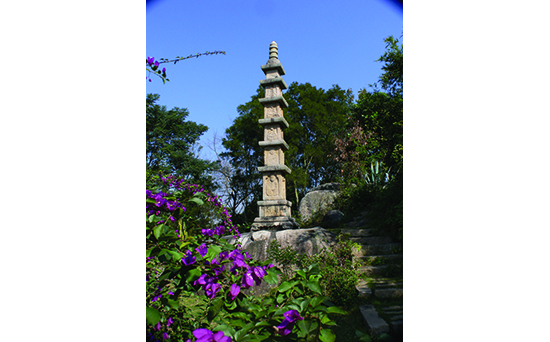Zhaojiabao Castle:
A Fortified Village in the Style of Song Dynasty's Capital City

East Gate of the Outer City Wall at Zhaojiabao

Wanbi (or Perfect Jade) Tower

The Resident Mansion of ZHAO Fan

Aspiration Hall

Buddha Gathering Pogoda

Stele Inscription by Mi Fu

Bianpai Bridge
A “City of Song Dynasty” built in Ming Dynasty can now be found to stand in the middle of Huxi Basin area of Zhangpu County in South China’s Fujian Province. Named as Zhaojiabao Castle, also known as Zhao Family Castle, it has been listed by the State Council among the Key Preserved Historical and Cultural Sites at National Level for “imitating the architectural style of Capital City of Song Dynasty” in every detail of its construction.
The castle is a masterpiece built by the descendents of the imperial family of Song Dynasty, and in China is a rare imitation architectural complex completed in Ming Dynasty. Across the world, the village is recognized as the sole “mini kingdom” which an overthrown royal family resided over hundreds of years. The weathered stone walls of the castle have witnessed the vicissitudes of Song Dynasty. In the year of 1279, the Yuan army captured Yashan Mountain, the last stronghold of Song Dynasty, and Zhao Family’s 320-year rule of China came to an end. Zhao Ruohe, the 10th generation of Zhao Guangmei whose brother was Zhao Kuangyin, the first Emperor of Song Dynasty, broke through the siege at the age of 13 and took secret residence in the coastal area of Zhangpu County. On the 5th year of the reign of Emperor Longqing in Ming Dynasty, Zhao Fan, the 9th generation of Zhao Ruohe, participated in the highest imperial examination, and became a Tien Si (a selected candidate to serve in the government) for ranking in the second grade. His career as a government official led him to the position of the Deputy Director of Zhejiang Provincial Public Security Department. After his retirement, Zhao Fan moved to the west side of Zhangpu Lake in the year of 1600, and started to build Wanbi Tower and the Inner City. Zhao Yi, Zhao Fan’s son, expanded the Outer City in 1619 in accordance with the style of Song Dynasty’s capital city (today’s Kaifeng city in Central China’s Henan province).
Zhaojiabao castle functions also to resist Japanese invaders. During the reign of Emperor Wanli in Ming Dynasty, the coastal areas were frequently harassed by Japanese pirates. The castle’s defending capacities were highlighted in the first and second constructions, and the design of “an inner city inside an outer city” became a peculiar feature. The castle consisted of three parts, the Outer City, the Inner City and the Wanbi Tower.
The wall of the Outer City is 6 meters in height, 2.4 meters in width, and 1,200 meters in perimeter. Huge blocks of stones were used to lay down the foundation, and triple mixture concrete was used to build the wall body. Four gates were designed in the Outer City, with the North Gate as the front entrance. Outside the front entrance, there is an encirclement in the shape of an irregular hexagon. The wall of the Inner City is 6.2 meters in height, 0.8 meter in width, and 222 meters in perimeter. Two gates were built in the North and the West. The North Gate, which is also the front entrance, is constructed in two storeys. The whole body of the gate is built with stripes of stones. Small windows can be found at two sides of the gate for the inspection of circumstances outside the gate. In the center of the Inner City, there is the “Imperial Palace” with a wooden board bearing the calligraphic words of “Wanbi”, which is an expression of the Zhao family’s wish for the restoration of their power over the empire. The first Chinese character “wan” is written in the up-down structure, which is suggestive of the pathos and frustration of “Upholding the rule of Song Dynasty while living in the reign of Yuan Dynasty”. The second Chinese character is written in left-right structure than its usual up-down structure. Besides, the constituent part of “yu” (literally “jade”) is written as “wang” (literally “emperor”), which is compressed to the left lower corner of the whole character. Meanwhile, another constituent part of “xin” (literally “hardship”) is lengthened and takes up the whole space at the right side of the character. Such way of writing implies that the royal family had been forced to take residence in a faraway place and to undergo all the hardship of re-starting their lives after the end of the Song Dynasty. The third character “lou” (literally “tower”) is written in the semi-cursive style of an up-down structure. The upper part of “song” (referring to Song Dynasty) and the lower part of “an” (literally “security”) speaks of their expectation for secure settlement and longings for their homeland in North China. The wall body, the windows and the secret tunnels are all capable of high defending powers. According to the overall arrangement, this tower is left unused during peaceful times. In periods of war, the entire residents would take temporary shelter in the tower. To the northwest of tower’s courtyard, there is a row of water channels, in which a tunnel of 0.6 meter wide and 1.2 meters high connects with outside area of the city. When the pirates or enemies launch attacks, this tunnel can be used for communication with the outside.
The magnificent imperial palaces of Northern Song’s Bianjing city cannot be found any more in the present time, yet traces of the ancient capital city can be discerned in many individual buildings in Zhaojiabao castle in terms of architectural designs, structural details, and naming conceptions. For example, there used to be “Xianqiao” (literally “Fairy Bridge”) at Jinming Lake in the capital, which was a giant arch bridge connecting the bank and the buildings in the center of the lake. The bridge had red-painted banisters and parallel pillars underneath to form three arches. The bridge hunched high in the middle, and thus was called “Luotuohong” (literally “Camel Rainbow”). At the far end of the bridge, a complex of palaces and halls were built as a living quarter for the Emperor during time of recreation. Similarly there was also a stone bridge stretching across the Lotus Pond in Zhaojiabao. Its name of “Bianpaiqiao” (literally “Song-styled Bridge”) was carved on the stone beam beneath at the north side of bridge, suggesting the architectural pattern is of the same style with that of the capital in Northern Song Dynasty. The mansion of Zhao Fan to the southeast of the bridge resembled also the layout of Jinming Lake buildings. Due to the many floods of Yellow River, the capital of Song Dynasty now has been 7 meters underneath the sand, and we can find nothing but an iron pagoda standing to demonstrate the city’s glory in history. To the northwest side of castle, there is a similar stone pagoda of “Jufobaota” (literally “Buddha Gathering Tower”), which is 1/10 in height of the iron pagoda.
Large hillock areas in the southwest, northwest and northeast of Zhaojiabao castle have been built into “Bianpaiyuan Gardens” (literally “Song-styled Gardens”). Zhang Ruitu, a well-known calligrapher in Ming Dynasty, wrote for the gate board of “Songzhucun”(literally “Village of Pines and Bamboos”). The two Chinese characters of “Shuoshan” (literally “Great Mountain”) in carved-in script style resemble the “lacquer style” created by Jin Nong, a great calligrapher and painter in Qing Dynasty. The two extant King Yu Tablets from the castle’s Temple of King Yu are apparently carved after the rubbing copy of the same tablet from the Platform of King Yu in the capital. The stone tablet of “Mochi” (literally “Ink Pond”) is carved following the rubbing copy calligraphy of Mi Fu, a great calligrapher and painter, when he served as the Military Commander and Magistrate of Wuwei Prefecture in Song Dynasty. Also in the small yard of “Jiqing”, there is a stone sculpture with the Chinese characters of “Chaoyunlaixin” (literally “Fragrance of Cloud Nestle”). The upper triple strokes of the first character “Chao” is carved either in the similarity of a flock of wild goose flying to South China or floating clouds. And “Chao” became “Guo” (the same pronunciation of Chinese character “Nation”). The character thus shaped represents longings for their hometown in North China. The lower part of “guo” can be further divided into an upper part “Tian” (literally “Farmland”) and a lower part “Mu” (literally “Wood”), which is purposely written as “Mi” (literally “Rice”, with a connotation of “Home” as well) to remind the Zhao descendents of the falling down of the Song Dynasty as well as their family.
During the long travel when the descendents of Zhao family migrated southward, peculiar folk customs reminiscent of the glories of Song Dynasty and the longings for their homeland were formed in farming, marriage, festival and entertainment. These constitute an important part of the Intangible Cultural Heritage of the Southern part of Fujian province. For example, on the 15th day of Lunar January, an annual event of “Kaogui” martial contest will be held in Zhaojiabao. The highest prize is a 15kg “Guizaigao” (glutinous cake in the shape of a turtle). In the Chinese language, the word “gui” (literally “turtle”) shares the same pronunciation as “gui” (literally “return”). The Zhao ancestors held the event to encourage their descendents to practice martial arts and hopefully reclaim the lost lands and return to the capital. On every 18th of Lunar January, the “imperial examination” would take place to select talents to participate in the county and provincial exams. The exam took the form of lantern-riddle, poem-writing and antithetical couplets. On the exam day and also on the 16th of Lunar August, the Zhao family would piously “invite” the statues of the 18 emperors of Song Dynasty as well as the first ancestor of Zhaojiabao castle, Emperor Guan Yu, local gods and the God of Wealth from the temples to parade into and out of the castle, which has been known as “Zoushe”. Also in most areas of China, brides and grooms wear colorful dresses on the wedding day. In the village of Zhaojiabao, the couples would be in white dress and trousers. The bride would also wear a white apron and hold white cloth stripes in hands. The outfit is called “Xiangtouyi” (literally “Elephant-head Dress”), and it expresses Zhao Fan’s hope that the descendents shall not forget about revival of Zhao family. The folk art performing custom of “washe” (literally “performance house”) since Northern Song Dynasty had also been carried on in the castle. For example, during festivals or resting time, folk artists would come to perform puppet show, Taiwan Opera, Hobby Horse Opera, Dachegu, etc. Of those, Escorting Lady Jingniang for Thousands of Miles and Raccoon for a Prince were the two favorite pieces for Zhao Family members.
During the reigns of Emperors Yongzheng, Qianlong and Jiaqing in Qing Dynasty, many descendents of Zhao Family in Zhangpu County crossed the Taiwan Strait to settle in Townships of Shulin County of Taipei, Jiayi, and Dadushe in Taichung. In recent years, the prosperous population of Zhao Family have visited Zhaojiabao castle many times to trace back and pay tribute to their ancestors. Some of them have built a duplicate Zhaojiabao Castle in Taiwan. The tower is structured in three floors. The first floor is “Ju’anju Quarter”, the second floor is Wanbi Tower, and the third floor is Ancestral Hall of Zhao Family. Rich historical documentations of Song Dynasty can be found in the tower. The board calligraphy of “Wanbilou Tower”, “Dongfangjuzhang” (literally “Oblong Barrier in East”), “Shuogaojusheng” (literally “Great and High Settlement with Beautiful Scenery”), and “Dandingzhongxiang” (literally “Auspicious Noble Life”) have all been copied from Zhaojiabao castle.
Walking in the historical site of Zhaojiabao castle, one feels like travelling back over a thousand years and living in the prosperous capital of Song Dynasty.
